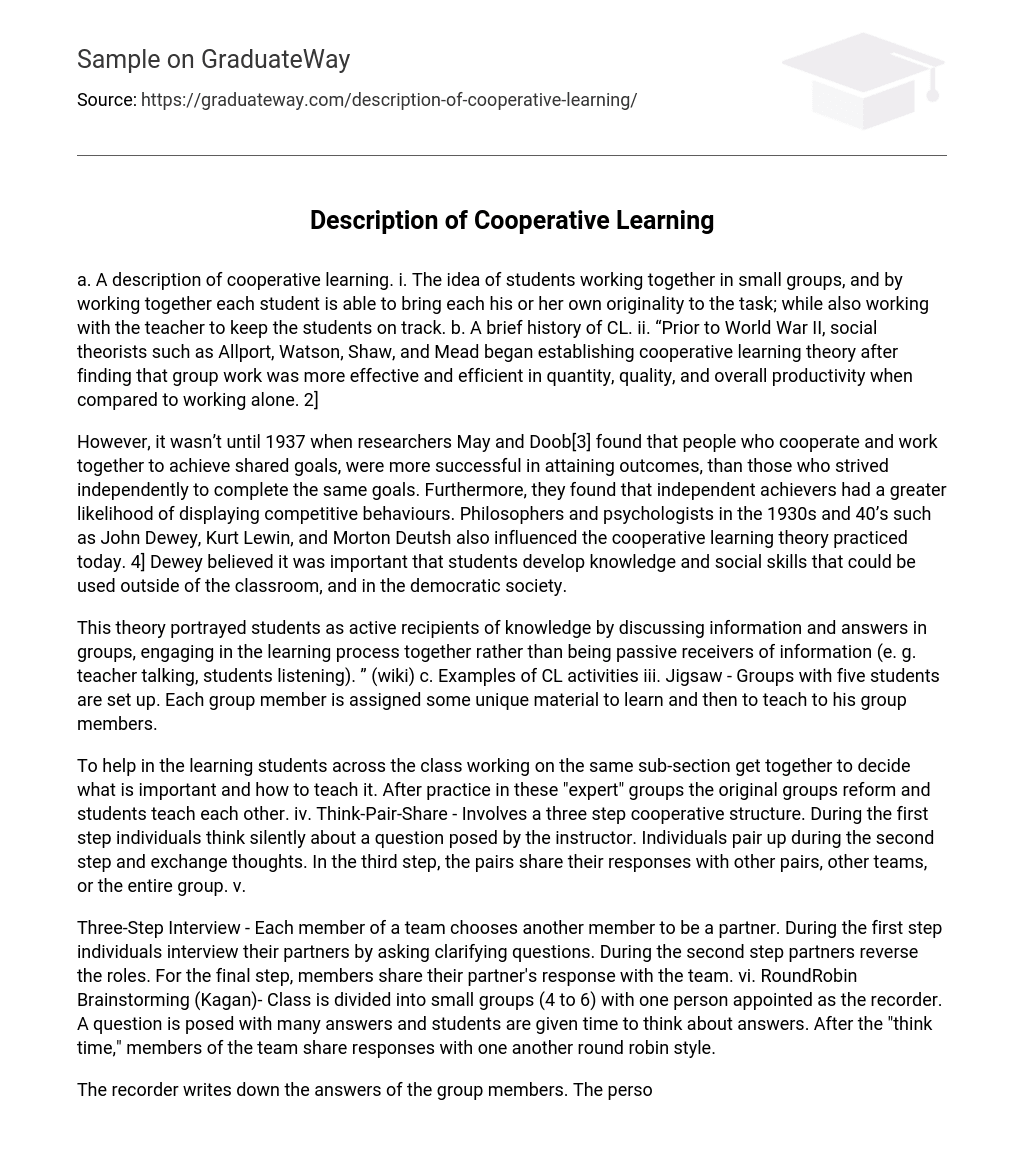a. Cooperative learning can be described as students working in small groups and utilizing their individual creativity while also receiving guidance from the teacher to stay focused on the task.
b. The origins of cooperative learning can be traced back to social theorists like Allport, Watson, Shaw, and Mead who recognized the superior effectiveness and productivity of group work compared to working individually, before World War II.
In 1937, researchers May and Doob[3] discovered that people who work together and cooperate to achieve shared goals have more success in reaching desired outcomes compared to individuals striving independently. They also observed that independent achievers are more likely to engage in competitive behaviors. During the 1930s and 40s, influential philosophers and psychologists like John Dewey, Kurt Lewin, and Morton Deutsh contributed to the cooperative learning theory practiced today[4]. Dewey emphasized the significance of students acquiring knowledge and social skills applicable beyond the classroom, particularly in a democratic society.
According to the theory, students are depicted as active participants in the learning process. Instead of passively receiving information from the teacher, they engage in group discussions and activities. One example of such an activity is the Jigsaw method where groups of five students are formed. Each group member is given specific material to learn and then tasked with teaching it to the rest of the group.
To support learning, students within the class collaborate in small groups to determine key concepts and teaching methods. After practicing in these expert groups, the original groups reconvene and students instruct one another. Furthermore, a cooperative structure called Think-Pair-Share involves three steps. Firstly, individuals reflect silently on a question presented by the instructor. Secondly, individuals partner up and exchange their thoughts. Finally, the paired individuals share their responses with other pairs, other teams, or the entire group.
The Three-Step Interview involves team members choosing partners and conducting interviews by asking clarifying questions. In the second step, partners switch roles. In the final step, members share their partner’s responses with the team.
Another collaborative activity is RoundRobin Brainstorming, where the class is divided into small groups with a designated recorder. A question is asked, and students have time to think about their answers. After the thinking period, team members share their responses with each other in a round-robin style.
The recorder takes notes of the group members’ answers. Starting with the person next to the recorder, each group member provides an answer in sequential order until the allotted time is up. d. CL limitations vii. Cooperative Learning has several limitations that could make the process more complex than initially thought. Sharan (2010) states that the ongoing evolution of cooperative learning poses a threat. As cooperative learning constantly evolves, there is a chance that teachers may become confused and not fully grasp the method.
According to wiki, teachers who implement cooperative learning may face challenges with resistant and hostile students. These students might believe that they are being held back by their slower teammates or feel ignored or demeaned by their team because they lack confidence. However, the benefits of cooperative learning are significant. Students who engage in cooperative learning learn more, remember it for a longer time, and develop better critical-thinking skills compared to their counterparts in traditional lecture classes. Additionally, students tend to enjoy cooperative learning more than traditional lecture classes, making them more likely to attend classes and complete the course. Cooperative learning is also beneficial because it helps students develop teamwork skills necessary for future jobs. It allows them to work on projects that are too difficult and complex for an individual to complete within a reasonable timeframe.
References 1. Kagan, Spencer. Cooperative Learning. San Clemente, CA: Kagan Publishing, 1994. www. KaganOnline. com 2. Gilles, R. M. , & Adrian, F. (2003). Cooperative Learning: The social and intellectual Outcomes of Learning in Groups. London: Farmer Press. 3. May, M. and Doob, L. (1937). Cooperation and Competition. New York: Social Sciences Research Council. . Sharan, Y. (2010). Cooperative Learning for Academic and Social Gains: valued pedagogy, problematic practice. European Journal of Education, 45,(2), 300-313. 5. Cooperative Learning. (n. d. ). In Wikipedia. Retrieved september 9, 2012, from http://en. wikipedia. org/wiki/cooperativelearning. 6. Rebecca Teed, John McDaris, and Cary Roseth, Cooperative Learning, starting point. September 9, 2012, from http://serc. carleton. edu/introgeo/cooperative/index.html. Author, A. (Date Published). Article name. Name of website. [Retrieved] Date, [from] URL of Website 7.





